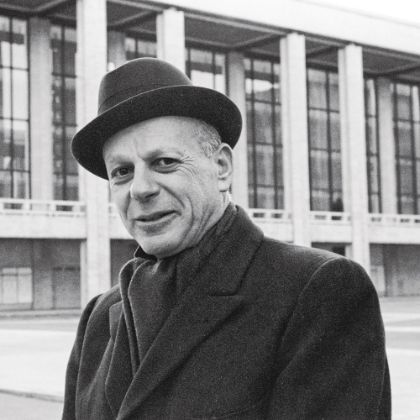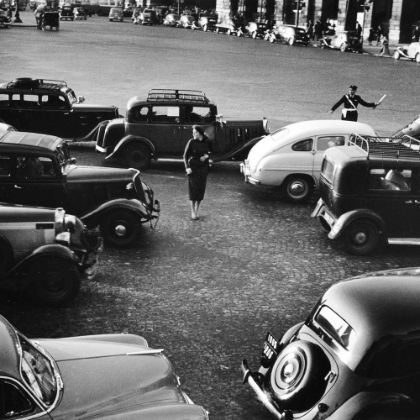Inside the work and philosophy of Helmut Lachenmann
By Paul Griffiths
What do we hear when we listen to music? Sounds, of course. It seems obvious. A lot of music, however, induces us to hear through its sounds to its notes — through a clarinet tone, with qualities of weight and warmth, skills of attack and control, to middle-register E-flat, which leaves the clarinet behind to find its meaning in relation to other notes in, say, a passage in C minor. Hence the rivalry, or at any rate ambiguity, that has persisted down through the history of music. On the one hand, sounds: immediate, almost palpable, each robustly itself. On the other, notes: immaterial, abstract, each with connections to others in a continuing skein. There were always composers for whom sonic effect was important. Berlioz was one. But even Berlioz’s Symphonie fantastique, with its distant shepherds’ pipes and bells, could be reinvented at the piano, as Liszt demonstrated, its notes intact but by no means its sounds.
The breaking point came a little over a century ago. Stretched by ever stranger harmonies and progressions, traditional tonality seemed to have reached an end point. Schoenberg’s solution, of course, was to let the notes loose into new configurations. More drastically, Schoenberg’s Italian contemporary Luigi Russolo abandoned notes altogether to create an “art of noises,” performed by mechanical percussion instruments of his own invention.
Russolo’s “noise-intoners” were all lost or destroyed long ago, but the impulse to make a music of sounds survived. In the spheres of electroacoustic and percussion music, this will often be the most straightforward approach. To insist on sonic character when dealing with the piano, the orchestra, or the string quartet, however — to go against what we take as normal and find new ways in which these media can sound — requires a whole other level of imagination and perseverance. That has been Helmut Lachenmann’s achievement, in half a century of creative work.
Music, with Lachenmann, is sounds, but it is also more. Lachenmann does not want us to forget the instrument or the performer — to experience, in each sound, however strange, the beauty of the instrument and the performer’s skill. At the same time, he has striven for aspects of coherence, drama, and expressive power as strong and as forthright as in more conventional music.
Let’s take as an example Lachenmann’s third string quartet, Grido, which happens to be available in a spectacular recent recording by the JACK Quartet (Mode Records). I wrote the liner notes for that album, but here I want to try to describe what an owner of the CD doesn’t need to know: what the piece sounds like, and how it grows.
“Grido” in Italian means “I shout,” yet the dynamic character of this quartet is more that of a whisper or a faint song. Even so, at the beginning you might feel the echo of someone crying out, with the second violin, viola, and cello all up in a high register, the first violin very soon cutting in below, everything generating the sensation that this, right away, is a situation of supreme intensity. Despite the first violin’s incursion, or perhaps because of it, the high sound is maintained, at once invigorating and piercing, like ozone-rich air. Lachenmann has a house above Italy’s Lago Maggiore, and sometimes in his music, as here, one may have the sense of the dazzling white and the tight chill of winter in the mountains.
Within seconds of this initiation, you recognize that things are happening up there — sounds are sliding down, fluttering, edging along through small intervals — but something is also staying the same. The second violin is holding on to its note — or, rather, its sound. For its character, this sound has to be up in an elevated register, and it must not be entirely stable, endangered, slowly fluctuating in dynamic level, and being joined or countered now and then by sounds from the other instruments. The first violin intermittently touches the same sound, the cello takes over for a while, and neighboring sounds come forward searingly at certain moments. By such means is the sound kept alive, ringing on, throughout the first minute of the twenty-five-minute piece.
Another recent recording on the Kairos label offers Grido II, Lachenmann’s transcription of the quartet for orchestral strings, as played by the young musicians of the Lucerne Festival Academy, along with his Schreiben of 2003, which remains his latest orchestral work. (Lachenmann’s output has been sparse of late, with no new work since 2008, when he completed a scena for soprano and piano, GOT LOST. In part this is the fault of his delayed recognition, which has brought calls to coach orchestras and solo musicians around the world, so that he has become the chief airmile-earner among contemporary composers.)
Schreiben is not only Lachenmann’s most recent orchestral piece but perhaps also his most outgoing. Through much of it there runs, from one section or soloist to another, a rapid susurration or flickering, the half-humorous sound of what is indicated by the title, “writing,” or perhaps something more like scribbling — a sonic realism also found in Lachenmann’s opera, after the Hans Christian Andersen story “The Little Match Girl.” But there are also slow waves of brass-led clamor that reach a condition of formidable power shortly before the end, these separated by passages where the texture characteristically thins to leave a tense suspense. In one such passage, ethereal harmonies suggest the shō of Japan, reminding us that Lachenmann, so western and German in the integrative energy of his music, is simultaneously eastern in his fastidiousness and otherness.
Grido II has something over its quartet prototype in richness of sound and bass weight, not least at the glorious moment of spectral harmony — a typical Lachenmann treat — about a fifth of the way through. However, it is hard to forgo the continuous vividness the JACK Quartet brings to what is essentially the same music. With them, in that first minute we are being taught how to listen — how to listen differently. We are being given, in that continuing high sound, a point, which will turn out to have been the starting point of a slow, slow melody that unfolds through the composition from beginning to end, the rope we can hold on to as we traverse the cliff face.
John Cage wanted to “let sounds be themselves.” Lachenmann does not “let” anything; he actively creates. But what he creates is an astonishing and — once one acclimatizes oneself — exhilarating autonomy for his sounds, which seem to be taking part — acting indeed of themselves — in a drama of embrace or repulse, support and blending or contradiction and separation, building a pattern or breaking it, calling a halt or inviting a continuation, plunging in or signing off. As far as we who listen are concerned, it is not primarily the players who are doing this, and it is not primarily the instruments, essential as both conspicuously are. The kind of pathos that comes from music presenting itself as conversation, whether among the musicians or among the instruments as surrogate human voices, is foreign to Lachenmann’s aesthetic. It is the sounds that are doing the work here, interacting and evolving.
Extended techniques. David Stromberg in a YouTube performance of Helmut Lachenmann’s Pression. By applying extra pressure to the strings, and playing near to — and on the opposite side of — the bridge, he produces the distorted, non-traditional sounds the composer demands.
We know, of course, in the case of Grido, that four expert musicians are producing those sounds, and producing them in response to a fully detailed score that the composer put together. While we are experiencing the music, however, that kind of knowledge recedes. Lachenmann has said a lot about wanting to disclose, not conceal, the physical effort and the exacting control that go into high-level musical performance, and so it is here. The fizzing energy of the music comes largely from the evident action in producing it, keeping it going, taking it over, sustaining it against competition. All that action, however, we experience as sound. All that action reveals itself in sound.
It is not just that the sound gains immediacy by lifting off from the conditions of its performance, conditions on which, paradoxically, it so much depends. It also does so by lifting off from the conditions of its composition. We know, again, that the composer has defined what will take place. If you want to check this, you can easily find the first page of the score online. But so much do the sounds seem to be exerting themselves as if of their own will that the score becomes invisible. Yes, a plan is being followed. It is, however, as if responsibility for that plan belonged with the agents carrying it out: with the sounds. It is as if nothing existed before the instant of sounding, as if what we hear is how the sounds themselves are behaving, in response to tensions contained in their nature and in how they relate to one another and interact.
This impression of sounds acting as if of their own accord (or discord) is something we all owe to electroacoustic music, where there are no performers, and where, because of that, our normal understanding of the composer’s involvement is unsettled. That normal understanding probably involves the notion that the music we hear being produced by performers is a realization of music the composer imagined and, by means of a score, set down. It is music that carries within it the trace of the pen, of writing (an effect Schreiben makes into a joke). But electroacoustic music will almost certainly not have been written in this way, and the means by which it was composed may well be impossible to discern. Having no obvious way to comprehend the composer’s role, we project responsibility on to the sounds, as if they were making themselves, directing themselves, not being made and directed.
Lachenmann has done very little electronic work, but that little has been decisive. A few of his orchestral compositions include recordings — most strikingly, if also most discreetly, his clarinet concerto Accanto, in which a recording of Mozart’s work of the same genre is fleetingly heard, as if from some other space. More significantly, as a young man he composed a tape piece at one of the early European studios, in Ghent: Scenario. As this title indicates, the piece has the dramatic flair one associates with Lachenmann’s instrumental music; it even ends, characteristically, with a brief glimpse of another world beyond what we have heard. With its bounding noises, its long reverberations in vast invented spaces, and its hints of vocal utterance, it also suggests its composer had been listening productively to Stockhausen’s Kontakte.
Despite this impressive beginning, Lachenmann produced no successor, perhaps because what he has always wanted is the energy and presence that can come only from performed sound, from sound being performed with incredible virtuosity — but perhaps also because he had learned enough. Most importantly, he had learned how sounds could seem to be creating their own courses. Hence, when he took the electronic experience back to manuscript paper, he invented the term “instrumental musique concrète” for what he was doing, which was to create what the pioneers of electroacoustic music in Paris had created, an art of sounds that are concrete objects, not to be considered merely as vehicles of pitch, duration, loudness, and timbre. The difference would be to achieve that now with instruments, in performance.
Lachenmann fully instituted his new approach in just a few works from between 1968 and 1971, a period that also saw the full emergence of New York minimalism and, in the wider world, the climax of a decade of progressive social liberalization — not a coincidence, if we believe that music participates, in this case by liberalizations of its own, in much broader phenomena. Appropriately, in testing out something new, Lachenmann proceeded at first with care. In particular, he avoided conventional sounds and kinds of articulation in order to keep clear of regular expectations with regard to form and meaning. A lot of music had already been written in which “special effects” — taps on the body of a string instrument, say, or woodwind key clicks — had been treated as indeed special, as heightened moments in a normal discourse. For Lachenmann, that was like putting a dissonant chord into a piece in C Major — an interpolation that had no meaning beyond its immediate shock value. What he wanted was a music in which “special effects” would no longer be special, a music where performers would be outside the boundaries from the start and stay there.
‘It is as if nothing existed before the instant of sounding, as if what we hear is how the sounds themselves are behaving.’
That did not mean they could be reckless. Quite the contrary: to produce new sounds requires no lessening of control, and many of the sounds Lachenmann wanted his musicians to discover were at the extremes of delicacy. His solo cello piece Pression is a case in point. The title means “pressure,” but the effect of high pressure here is to squeeze out how little — and how much — is still available when the cellist ventures away from traditional techniques to make sound by, for example, sliding the left hand over the strings or bouncing the bow on the body of the instrument.
Pression is a classic, one mark of its status being the number of performances posted on YouTube (which, by the way, is a potent source for Lachenmann, making accessible a performance of Schreiben under Brad Lubman that compares very favorably with the new one on CD, despite the fact that this music of sounds profits from higher-quality audio reproduction). At a late stage in Pression, which plays only for about seven minutes or so, the cello discovers one “normal” tone in a middle register.
This choice is not, of course, accidental. The note is one that sounds full and warm on the cello while being somewhat contrary, partly because it is played on a string tuned down a semitone. Then again, it makes the instrument resonate, for the top and bottom strings are also detuned, to add sympathetic resonance and the echo of a major chord. Even tonality, therefore, is recovered and refreshed, if not now as a home. This is music that has long packed its bags and left, and that has confidence enough to look back without nostalgia or regret.
Lachenmann extended the innovations of Pression to a whole quartet in Gran torso, his first string quartet, which again has an exemplary performance from the JACK on their CD of the composer’s three quartets. Already he was realizing he would have to embrace notes alongside the noises that had constituted most of the cello piece, but, with the experience of the latter behind him, he could do so without going into reverse. If they were treated as sounds, and not as tokens in some pitch system, notes could indeed be sounds, free and independent.
One can overstate those features, however. When Cage talked about letting sounds be themselves, he meant without consequences. With Lachenmann, by contrast, consequences matter. Every one of his compositions so far is in a single unbroken movement, and most of them play for close to half an hour. Moreover, they do so coherently. The sounds are sufficiently themselves, and often appealing enough that one is invited to perceive them one by one, the whirligigs and the zooms and the sudden rabbits out of nowhere — to give them attention, and even to give attention to one’s giving attention, to become aware of the act of listening. This is another aspect of Lachenmann’s realism. But in the gathering storms of his great climaxes, or the comedy of his escalations, or the irresistible rushes of dance rhythm or toccata motion to which he is prone, one is bound to lose track of the separate sounds. They are becoming music.

related...
-

Master Builder
His compatriots made institutions of their music. William Schuman made institutions.
Read More
By Russell Platt -

Respighi: Beyond Rome
Respighi’s set of variations is cast away for his more
Read More
‘Roman’ repertoire.
By David Hurwitz -

L’amico Fritz
Mascagni delivers beautiful music, libretto be damned.
Read More
By Robert Levine